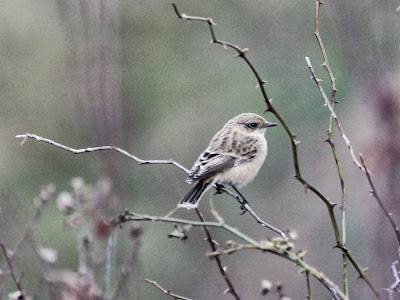It will not be too long now before ringing at Long Nab will end for the autumn. By mid November it usually becomes too wet and muddy to drive down to the site and by then it is unusual for there to be enough birds around the ringing site for it to be worthwhile anyway. So, I am trying to make the most of any breaks in the recent wet and windy weather that do allow us to operate a few nets. Micky and I caught a modest nine birds this morning which included two Goldcrests, two Lesser Redpolls and a retrap Robin from last year. This is the first time that particular Robin has been caught since October 2012, so we wonder where it has been in the intervening period. Good to know it is still going strong though!
A little bit of visible migration was in evidence overhead and included Siskin, Redpolls, Linnet, Goldfinch and Reed Bunting. A Snow Bunting and a few Fieldfares came in off the sea, but the highlight of the morning came whilst we were ringing a Blackbird and a female Hen Harrier suddenly appeared right next to us. It quickly reared up and headed off south being harassed by a Carrion Crow. Hen Harrier is always a treat to see, but a scarce bird at Long Nab and thus a most welcome sight.
Once we had finished ringing a check of the stubble field by the seawatch hut produced a Lapland Bunting and two further Snow Buntings in off the sea. Feeling enthused we opted to check the Cromer Point stubble field where two further Lapland Buntings were noted and a Pink-footed Goose was seemingly recently arrived and sat in the field. As we walked back to Crook Ness further Fieldfares came in off the sea accompanied by a Redwing, and two Goldcrests were noted in Crook Ness
Later in the day I checked Cornelian Bay on the south side of town, where at least 95 Fieldfares were recorded including several that I saw to come in off the sea.
 |
| Fieldfare - newly arrived from the sea at Cornelian Bay |






































